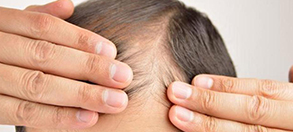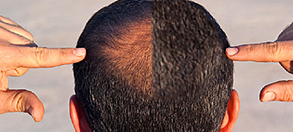
Cellular micrografting is a minimally invasive hair restoration technique that takes a small amount of healthy hair follicles and uses mechanical disaggregation to extract growth factors. These are mixed with saline and injected into the scalp to promote new hair growth. This treatment is intended for patients who are not quite ready for a hair transplant but want to stimulate hair growth without surgery. It can also be used to augment your transplantation. It uses a patient’s own growth factors created from healthy hair to promote their own hair to grow in thinning areas.
At Houston Hair Transplant Center (HHTC) we offer many types of hair restoration treatments and procedures, both surgical and non-invasive in nature. Dr. Goran Jezic is a double board-certified surgeon who specializes in hair transplantation. He has spent that last decade performing hair restoration for patients in Houston, Austin, and surrounding Texas communities.
If you are ready to take the next step in your hair restoration journey, schedule your consultation with Dr. Jezic today by calling (713) 864-2300 or filling out our online form.
Contents
- 1 What is Cellular Micrografting?
- 2 Benefits of Cellular Micrografting
- 3 Ideal Candidates
- 4 Personal Consultation with Dr. Jezic
- 5 Preparation
- 6 Cellular Micrografting Procedure
- 7 No Recovery and Quick Results
- 8 Corresponding & Complementary Treatments
- 9 How Much Does Cellular Micrografting Cost in Texas?
- 10 FAQ
- 11 References
What is Cellular Micrografting?
For those with pattern hair loss, there are limited treatment options apart from oral medication and hair transplantation methods to instigate new hair growth. It can be frustrating to find the method that works best, especially if you are waiting for the right time for a hair transplant. Cellular micrografting is a minimally invasive stepping stone toward healthy hair growth. Its intention is to strengthen donor and recipient areas for those with thinning hair and promote quick hair growth without surgery. Results are typically seen within 3-6 months.
How Does It Work?
The science behind cellular micrografting involves harvesting small amounts of healthy hair follicles and turning them into multipotent stem cells through disintegration and injection. (1) Dr. Jezic harvests healthy hair follicles from behind the ear. Capturing the entire follicular unit ensures the treatment will contain the growth factors necessary for regrowth. These healthy hair follicles are then placed with pure saline into a centrifugation machine that spins them very quickly using microblades to break them apart.
The result is a concentrated solution containing the functional matrices of the dermal papillae. The dermal papilla is the part of the hair follicle that contains cells that regulate and promote the hair’s growth cycle. (2) They also help generate the hair shaft. The centrifugation process creates a condensed solution of cells that are the precursors to proper hair growth. This solution is then safely injecting into the thinning areas of the patient’s scalp. (1)
Benefits of Cellular Micrografting
Cellular micrografting promotes the use of autologous material created from the patient’s own genetic makeup. It avoids the need for stem cells and speeds through the process by utilizing the patient’s own follicular cells to promote their own hair to grow. The result is natural hair growth, promoted by the body’s own processes.
Cellular micrografting provides pattern hair loss patients with a multitude of other benefits including:
- Increased hair density and thickness
- Slow or stop hair loss
- Promote complete hair growth cycles
- Minimally invasive
- Little risk of rejection
- No chemicals or unnatural materials
- No scalp inflammation
- Discrete treatment
- Easily combinable
- Can be done in an afternoon
This treatment promotes fast hair growth without causing scalp irritation and inflammation. There is no associated downtime, so patients can go back to their daily activities afterward. It promotes fast hair growth to provide them with longer, fuller, and healthier hair.
Ideal Candidates
You are a good candidate for cellular micrografting if you experience mild to moderate hair loss in the crown, temples, or middle scalp. This treatment is particularly effective if you experience hormonal hair loss and have increasingly brittle and thinning hair. You must also be in good overall health with no serious underlying medical conditions or autoimmune diseases.
Those with a receding hairline or severe hair loss are not good candidates and may require more advanced hair restoration like FUE hair transplantation. You do not qualify if your hairline is receding and you must have healthy hair available for donation.
Personal Consultation with Dr. Jezic
At HHTC, you will meet with Dr. Jezic for a private consultation. He will perform a medical examination to assess your health and candidacy. He will explain cellular micrografting in great detail to prepare you for treatment. This consultation will be the best time to ask any questions about the procedure, hair loss specifics, and anything else related to hair restoration. He may use this time to discuss hair transplantation if you are considering it. Dr. Jezic will focus on your cosmetic desires to ensure this time is well spent. Be sure to arrive with specifics about your medical and hair loss history. This will also be your time to schedule your future appointments. A member of the HHTC staff will assist you with this and make sure you are completely prepared.
Preparation
There is little preparation necessary for cellular micrografting treatments. Please avoid anti-inflammatory medications like ibuprofen leading up to your appointment. Refrain from smoking tobacco and nicotine products to prevent problems with healing. Dr. Jezic requires you to stop the use of other hair restoration medications or steroids. These may hinder the results of micrografting. Please avoid alcohol consumption and the use of herbal supplements like vitamin E and fish oil.
To best prepare you for this treatment, Dr. Jezic may take medical imaging and photography to ensure your scalp is healthy and can receive the treatment properly. By measuring the severity of your hair loss, he makes sure cellular micrografting is the best method of hair restoration.
Cellular Micrografting Procedure
Dr. Jezic first disinfects the area behind your ear and administers a local anesthetic just below the skin. Once the numbing takes effect, he utilizes a tool made specifically for FUE hair restoration to harvest 6 to 12 healthy hair follicles. He places these follicles into the centrifugation machine with sterile saline solution and rapidly spins them for around 2 minutes. The microblades break up the hair to release the dermal papilla matrices. After the solution is mixed, he then dilutes it with more saline and places it into very small syringes. He injects the growth factors directly into the thinning areas of the scalp and the treatment is finished. Micrografting typically takes 30 to 45 minutes to complete.
No Recovery and Quick Results
There is no recovery associated with this treatment. With no downtime, you are free to return to work and regular activities right after the appointment. You may experience a slight headache directly after injection, but this can be treated with over the counter medications if necessary. The tiny incisions made when gathering the donated hairs heal very quickly and are not typically visible because of their location behind the ear. You can wash your hair like normal and continue your daily medications right away.
After cellular micrografting treatment, you may see new hair growth in as little as 3 months. As long as the recipient area has hair follicles, they can be affected by the growth factors. Your hair grows in thicker and fuller, promoting more even hair distribution. This treatment may be repeated when necessary to further promote future hair growth.
Corresponding & Complementary Treatments
Autologous Conditioned Plasma (ACP) for Hair Loss
ACP treatments use micrografts to naturally stimulate hair growth with a patient’s own blood platelets. Dr. Jezic draws a patient’s blood and places it into a centrifuge. Spinning it at such a rapid speed separates the blood’s components by density. This allows him to extract plasma with a high concentration of platelets. He places this plasma in a syringe and injects it into the scalp to promote hair growth.
Typically performed alongside FUE hair transplantation, Dr. Jezic utilizes ACP to promote the growth of transplanted hair follicles. He extracts the platelet-poor plasma onto prepared hair follicles to nurture them, then injects the ACP into the scalp. In this process, he uses every portion of the donated blood to improve the hair transplantation procedure.
If you are interested in learning more about surgical hair restoration, please read HHTC’s blog.
How Much Does Cellular Micrografting Cost in Texas?
When compared to surgical options, cellular micrografting treatments are much more affordable than traditional methods of hair restoration. Every patient receives a customized treatment plan outlining the number of micrografting treatments and follow up appointments. Total cost will change depending on the patient’s starting point and cosmetic desires.
To receive an estimate from HHTC, please schedule your private consultation today. You may get in touch with our Houston and Austin, TX offices at (713) 864-2300 or contact us online. We look forward to hearing from you.
FAQ
Can cellular micrografting help with hair restoration?
Yes, cellular micrografting has been shown to be an effective technique for hair restoration. By transplanting micrografts containing hair follicle cells or activating factors into areas affected by hair loss, cellular micrografting can stimulate hair growth and improve the density and thickness of existing hair.
Is cellular micrografting a suitable alternative to FUE hair transplantation procedures?
No. Though it stimulates healthy hair growth, cellular micrografting cannot replace a hair transplant. If a patient has severe hair loss with no viable hair follicles in certain areas, then a hair transplant is their best and only treatment option. That being said, cellular micrografting is an optimal treatment to receive when waiting to get a hair transplant to promote current hair growth in donor areas.
Will cellular micrografting treatments stimulate hair growth on my crown?
Yes. The optimal locations for this technique are the crown, temples, and the middle of the scalp. It is not intended for use on receding hairlines or areas that are completely bald.
How long do the results of cellular micrografting last?
The longevity of cellular micrografting results varies from person to person and depends on various factors, including the specific technique used and individual biology. In some cases, the results of cellular micrografting can be long-lasting or even permanent.
References
- Zari S. Short-Term Efficacy of Autologous Cellular Micrografts in Male and Female Androgenetic Alopecia: A Retrospective Cohort Study. Clinical, Cosmetic and Investigational Dermatology. 2021;Volume 14:1725-1736. doi:https://doi.org/10.2147/ccid.s334807
- Morgan BA. The Dermal Papilla: An Instructive Niche for Epithelial Stem and Progenitor Cells in Development and Regeneration of the Hair Follicle. Cold Spring Harbor Perspectives in Medicine. 2014;4(7):a015180-a015180. doi:https://doi.org/10.1101/cshperspect.a015180


